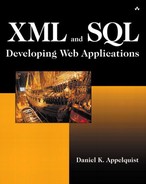Chapter 7. Related Standards: XSLT, XML Schema, and Other Flora and Fauna
In which XML is magically transformed, and the XPath to righteousness is revealed!
The development of XML has spawned a shadow industry of XML-based languages, each developed and promoted by its own industry group or consortium. Many of these standards seem to conflict with each other or with products that are already widely in use. Untangling it to find the right standard to apply to a particular problem can be, well, problematic.
In this chapter, I discuss some of the standards that I've found particularly useful in designing and building applications with XML and SQL. You'll discover how to transform your XML with XSLT and why XML Schema is fast becoming a replacement for XML DTDs. I'll also cover some approaches to querying XML documents and touch on the XPath, an important standard for referring to parts of XML documents.
As a rule of thumb, anything produced under the auspices of the W3C is going to be a relevant and utilized standard. Of course, the W3C devotes resources only to efforts that it considers “general” enough. So, for instance, the W3C has devoted quite a lot of effort to developing and promoting XML, but it doesn't get involved in efforts such as producing an XML vocabulary specific to news articles or other knowledge domains. The W3C develops the standards (such as XML) that enable these more domain-specific languages. An abundance of these domain-specific languages is available, covering fields from chemical formulas to legal contracts. Information on them can be found in the sites listed at the end of Chapter 5.
The standards discussed in this chapter are important tools that you should be familiar with when building any XML application.
